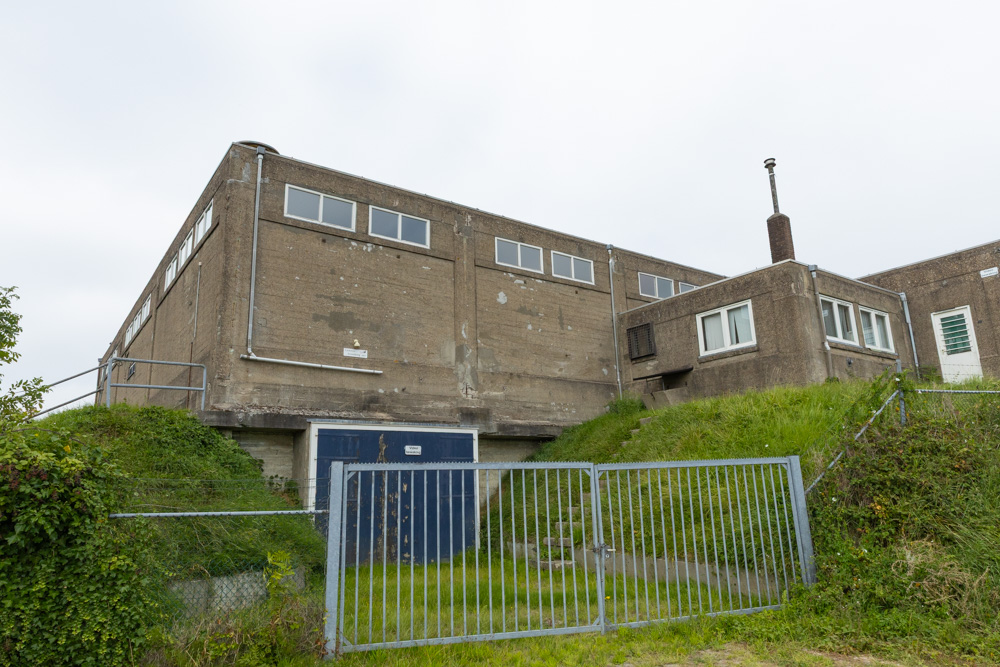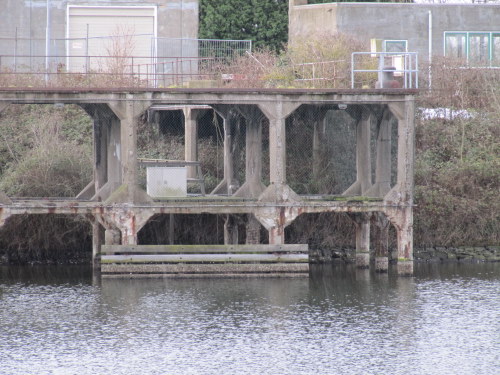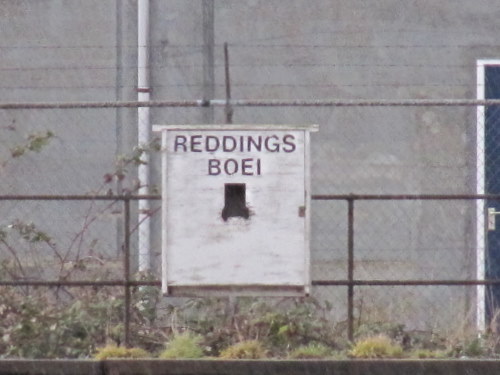Depot for Mines Veere
The mine warehouse was built by the Ministry of the Navy in 1916 and was constructed in monolith reinforced concrete. The building consists of a large hall with two floors, underneath the hall is another large space. In the meadow behind the warehouse are two more small bunkers that officially belong to the complex. The E-shaped jetty, also made of reinforced concrete, is unique in the Netherlands. The building next to the mine depot is the naval personnel's canteen building.
In the period 1919 and 1926, a branch of the N.V. Aircraft Factory (Fokker) was established in the then vacant airfield and Fokker aircraft and Hydroplanes in the series F-2 to F-7 were assembled.
The history of the deposit for the mobilization period:
By the Air Protection Act of 1936, Veere was classified in the first (highest) hazard class (with Vlissingen the only two in Zeeland), because of the seaplane pilots and the mine shed.
During the mobilization the so-called Detachment Veere was located in Veere, consisting of two sections of a Marine Company. They had the task of defending Veere. The Naval Air Base, the present mine warehouse and the locks to the Channel through Walcheren were protected from air attacks by the 76th Platoon Anti-Aircraft Machine Guns supported by three 20mm Hispano Suiza guns and an Air Base aircraft machine gun.
In 1940 Veere was a support base for the MLD. At that time there was only a mooring place (for seaplanes), a jetty, a shed and a few small functional buildings. The Veere base was occupied by 3 officers and 100 to 120 naval troops and other personnel, with the exception of the flying equipment and personnel.
The first days of the war :
On May 10, 1940, four operational and two non-operational Fokker C-XIV-w seaplanes were stationed.
On May 12 Veere was attacked by several He-111 bombers. One seaplane was completely destroyed, another was badly damaged. In the evening a tragic own fire incident took place for the second time. A patrol returned to base but was shelled. Three victims of the May days are known among the Dutch soldiers around the air camp, Sgt. Jacobus Gradus Bosman and Zeemil. Volkert Mijndert Deen (Bosman and van Deen were the victims of their own fire on May 12) at the airfield itself and Zeemil. Johannes Marinus de Vos in Arnemuiden. The sentries were under the impression that German paratroopers were attacking ...
The base was evacuated on May 14. Four still flying Fokker C-XIV-w seaplanes were flown to France and later they were to be flown to England via Cherbourg and onwards by ship to the Dutch East Indies. All (remaining) Fokker C-XIV-w would be lost there during battle or as a result of destruction by our own people. After a few more attacks by German planes on the base, the capitulation of Walcheren was a fact in the early evening.
Veere as a support base in 1940 to 1944:
The Germans also used Veere as a base, not as a main base. Sometimes aircraft from the Seenotdienst (sea rescue service) were observed, usually a Do-18, He-59, He-115 or a Do-24. Meteorological services also made occasional use of the base. However, the main base in Zeeland was Vlissingen. Veere was and remained a point of support, but also had access to the canal through Walcheren. Fifteen vessels of the Rheinschutzflottille were stationed in Veere. This Flottille only left at the end of October 1944, just before the liberation. At the end of 1942 and the beginning of 1943 a company of the Grenadier-Regiment 146 was located in Veere.
At the time, there was a Tobruk for a tank dome in the old rampart of Fort Veere for the defense of the support point, a Tobruk for a 5 cm tank gun at the head of the canal entrance, with a second Tobruk on the dike at the old fishing port. The foundations for the Tobruks can still be seen. There was also a Kabelschaltbrunnen (switching station for telephone cables) between Walcheren and Noord Beveland, of which the southern tensioner at Veere is also still present.
There are clear indications that there was a Sperrwaffenkommando in Veere. (Sperrwaffen include: anti-submarine nets, cable barriers and electronic barriers). The website of the Wings to Victory Foundation contains reports of crashes in the area up to October 30, 1944.
The inundation and liberation of Walcheren:
Veere also did not escape the inundation in 1944. After the reclamation of Walcheren, the depot has been used for various purposes to date. Now a decision has to be made about the future and the possibilities of the monumental building.
Do you have more information about this location? Inform us!
Source
- Text: Allert Goossens, Wilco Vermeer, Mia van den Berg
- Photos: Arjan Vrieze (1, 2, 3, 4), Mia van den Berg (5, 6, 7)
Related books
Nearby
Museum
- Small Museum the Veerse Gat - Veere
- Museum Wings to Victory - Arnemuiden
- Liberation Museum Zeeland - Nieuwdorp
Point of interest
- Coat of Arms Kleverskerke - Kleverskerke
- Former V-2 Launch Site Vrederust - Serooskerke
- Synagogue Middelburg - Middelburg
Monument
- Memorial Civilian Casualties Veere - Veere
- Inundation Memorial Veere - Veere
- War Memorial Gapinge - Gapinge
Cemetery
- Commonwealth War Graves Kamperland - Kamperland
- Dutch War Graves Middelburg - Middelburg
- Dutch War Graves Nieuw en St. Joosland - Nieuw en St. Joosland
Remembrance Stone
- Stumbling Stones Kaai 49 - Veere
- Stumbling Stones Kaai 47 - Veere
- Stumbling Stones Laan van Nieuwenhove 5 - Middelburg














